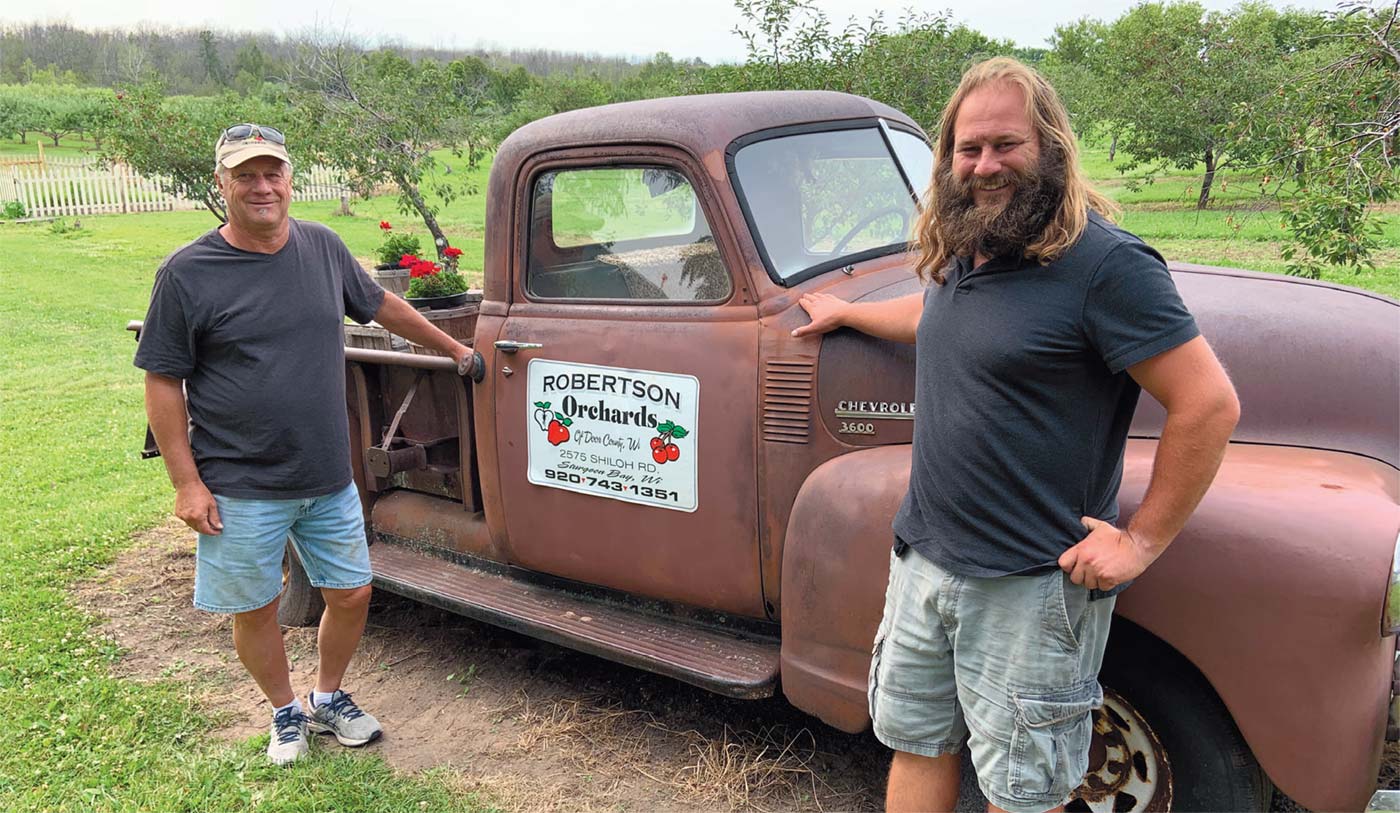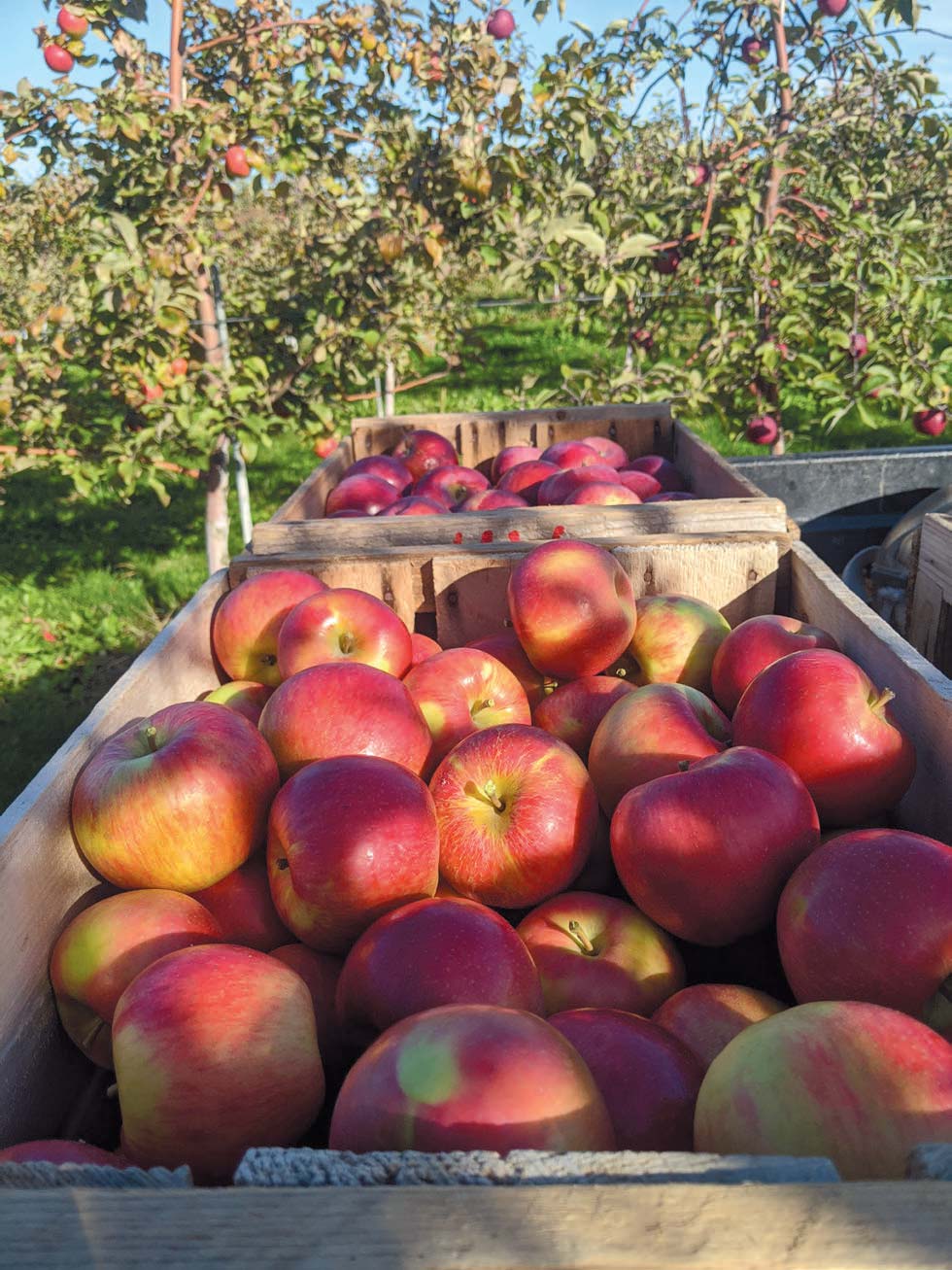Five Generations of Success on ‘Stony Acres’
edible Door archive from 2021 refreshed for edibleNEW premiere launch
Kris and Skipp Robertson represent the fourth and fifth generations of the Robertson family that have operated Robertson Orchards.
Situated on rolling hills just outside Sturgeon Bay, the orchard is familiar to the many who travel to the Door Peninsula is search of fruit each summer and fall. Its small colorful directional signs are strategically sprinkled along the roads leading into town. For those who don’t want to travel that far, the Robertson truck has been a familiar site at area farm markets, primarily in Green Bay.
I’ve had a first-hand account of the Robertson operation, having worked with Jim Robertson, Kris’ father and Skipp’s grandfather, at the Door County Advocate. I became acquainted with the chores associated with each season as pruning, spraying, shaking and transporting are all part of cherry season. By fall it’s apple-picking season. Like much of farming in general, many small orchard operations have gradually faded away, either absorbed by larger operations or vanished completely.
The Robertson story is a very unique Door County story and remains alive because of the willingness to change and adapt to what can be the Peninsula’s challenging growing conditions.
The family’s Norwegian roots probably played a significant role in forging such toughness. Very little of Norway’s land was tillable so subsistence was difficult and family tradition played a role since the oldest son in the family was often given first choice when the farm was sectioned off and passed to the next generation. Many of the younger sons were drawn to the growing Scandinavian communities in America.
Thanks to some excellent genealogical work, it’s fascinating to follow the trail to what eventually resulted in the Robertson farm. Two of those young immigrants were Tobias and Mikkel Resmussen, who each arrived in Chicago shortly after the Great Fire and applied their carpentry skills to help rebuild the city. A short while later they arrived in Milwaukee and were hired to help build a shipping canal in Sturgeon Bay that would greatly impact Door County’s future.
They liked the area, bought a nearby farm in 1879 and changed their names to Tom and Mike Robertson. The farm was populated with the traditional elements of a Midwestern dairy farm. Through Jim’s weekly newspaper column “Orchard Ole,” the orchard became known as “Stony Acres,” reflecting the geologic challenges farmers faced on the Door Peninsula that gave birth to its famed stone fences.
It would take a generation before the Robertson farm would begin its transformation into Robertson Orchard when Kris’ grandfather Roy began planting the cherry and apple trees for which the Peninsula was becoming famous.
Whether by coincidence or planned, Roy planted three orchards in the three years his children were born and that eventually marked the transition from dairy and crops to all orchard in 1947.
Less than a decade later Roy died and Jim purchased the farm, marking the third generation of family ownership.
Jim would eventually sell the orchard to Kris in 1994 but while he owned it major changes would impact both the cherry and apple industries. Cherry harvesting had long required manual labor, requiring thousands of migrant workers to clear the trees of fruit, but the development of mechanical harvesters changed all that.
In a span of just 10 years mechanical shaking of trees replaced pickers and Jim was one of the first as he partnered with Sawyer Farms in purchasing a pair of hydraulic machines in 1963.
Just three years earlier the Advocate predicted just such a revolution. “But then, there weren’t many believers in the Advocate’s prediction of a revolutionary movement in the cherry industry,” he wrote. “When I started pruning the bottom of trees for my mechanical harvester, oldtimers shook their heads. When we took the shaker out the first time and squeezed a couple of limbs until the sap squirted out, they shook their heads even more.”
There were problems to overcome with such a new device but it wasn’t long before the harvest was, as Jim described it, “a complete family deal” confined to himself and his three sons.
As Jim passed over the reins to Kris in 1994 it was easy to see where the business was going as pick-your-own cherries were becoming a bigger and bigger part of the harvest as was the farmer’s market business.
“People like to see where their food is coming from,” said Kris, as he and Skipp watched customers make their way up the driveway to go picking or find ready-picked fruit in the coolers.
It took just three weeks for the sign-followers to completely pick out Robertson’s cherry crop this year.
The pick-your-own apple season gets underway in early September and represents the changes Kris and Skipp have made to extend the season as cider absorbs much of the harvest. While the shelf-life of the produce is limited, frozen cider remains popular for far longer.
After a little calculating, the two agree that they grow 15 varieties of apples and pears. Developed at the University of Minnesota, the Honeycrisp almost immediately became a sensation when it hit the market in the 1990’s. It remains Robertson’s top seller.
As Kris and Skipp ponder the fact that the original farm will be 150 years old in 2024, they don’t take for granted the generations before them. As soon as Skipp took over ownership in January of 2020, a priority was to fix up some of the existing buildings.
“I can’t expect the buildings to hold up,” he said. “There won’t be a development on this property as long as I’m alive.”
That brought a smile to Kris’ face as it likely would to Mike and Roy … and Jim, too.
“I think my dad would be pleased with what we’ve done,” said Kris, referring to his Dad who died in 2000.
I’m pretty sure he would, too.
AN APPLE A DAY REMAINS IN GOOD TASTE
NO FRUIT is more acutely associated with fall than the apple. One of America’s most popular fruits, the apple’s appeal (no pun intended) is bolstered by folk tale and clever adages that seemingly come right from some of the country’s most successful advertising agencies.
None has been more successful or lasted longer than “An apple a day keeps the doctor away.”
But while many of us question the validity of some of today’s sales pitches, the longevity of the apple phrase is primarily due to the fact that few discount the claim. Even today when social media can spread false rumors quickly, the apple seems to stand up well to public scrutiny.
Although he is often credited with coining the phrase, Benjamin Franklin did not. The actual author is not really known. In a story that appeared in The Washington Post, author Caroline Taggert perhaps offered the best historical reference to the adage.
“It sounds as if it should be really old, but in fact the first recorded use is in the 1860s, when it is said to be an old saying from Pembrokeshire in Wales,” Taggert wrote in her book “An Apple a Day: Old- Fashioned Proverbs and Why They Still Work.”
Taggert wrote that the phase dates back to “Eat an Apple on going to bed, and you’ll keep the doctor from earning his bread.” By the late 19th century and early 20th century, the phase was shortened to “an apple a day, no doctor to pay” and also “an apple a day sends the doctor away.”
But is the claim true? Apparently, the health benefits of apples go back thousands of years to the Ancient Romans and Anglo-Saxons. In the Post story, Taggert mentioned the fruit appeared in traditional Ayurvedic medicine in southern Asia.
Researchers have continued to study the affects of apples on diet to the present day, some driven by that most common of all medical prescriptions. In the website “Eat This, Not That!” registered Nutrition and Dietetic Technician Sarah Garone writes, “Apples are full of one nutrient most people don't get enough of—fiber. With 5 grams per medium fruit, a single apple knocks out 20% of your daily target of 25 grams. Not only does fiber smooth your digestion and prevent constipation, it promotes a healthier microbiome (aka the good bacteria in your gut). Much of apples' fiber comes from pectin, which produces an acid called butyrate. This acid is especially known for feeding beneficial gut flora.”
The Post story references an Ohio State study that found that eating an apple a day helped significantly lower levels of bad cholesterol in middle-aged men and a Dutch study found that eating apples and pears might help prevent strokes.
“To protect yourself against cardiovascular disease and several forms of cancer, it’s important to include at least seven servings – and preferably more – of fruits and vegetables in your diet every day, but there’s one particular type of fruit you want to make sure you eat every day, it’s an apple. Better yet, eat two,” said Dr. James Barnard, UCLA professor and researcher.
But somehow a fruit that at one time was such an integral part of American society, lost its way in our food chain. We have always loved our apple pies, and an apple is still best each fall with dipped caramel. But once there was a time when apple consumption was driven by hard cider.
Cider was once the quintessential American beverage. Colonial men, women and children drank cider by the tankard, as it was a safe beverage and readily available, made from apple cultivars that colonists brought with them from England. The legendary Johnny Appleseed continued this trend westward as he sowed apple trees that were not the sweet-eating apples we buy at the market today, but rather crabapple-like varieties more suited to making cider.
But German immigration and its beer-making culture combined with Prohibition to reduce hard cider production. Much of that orchard land that was set aside for cider apples was converted to the sweeter eating apples that play such a huge role in keeping the phrase alive.
Taggart believes the longevity of “an apple a day” rests in its simplicity.
“One of the odd things about this proverb is that it means exactly what it says,” she said. “Apples are good for you. That may be why it’s popular. You can take it at face value.”






